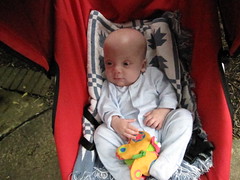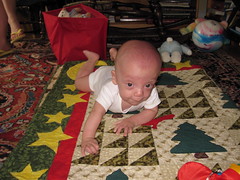All kidding aside, managing Max's care seemed absolutely overwhelming at first, and, although we've started to settle into a routine, it remains a lot of work. However, it's rewarding work: Max loves getting a sponge bath, for example. In addition, as we gain confidence, we're tweaking Max's care based on our own thinking of what he needs. Of course, our first tentative steps away from the care instructions we came home with resulted in Max losing weight--a big deal for recently released babies. But, seriously, who makes any progress in life without a few missteps? We're learning as we go along.
Because Max can only tolerate a tiny amount of food by mouth, we rely on a pump hooked up to his ng tube to deliver almost all of his calories. If he's going to get over his reflux, he's going to have to get big and strong. Here's a picture of the pump:

The big metal pole is just that: a big metal pole to hang stuff from. The pump is the small box about half-way up. It's an infinity orange model enteral feeding pump. Every morning we break out a new plastic food bag to hang from the metal pole. Max gets formula during the day and fortified breast milk at night. This model pump can handle both formula and the thinner breast milk. The pump has a battery pack that we charge at night and comes with a discreet backpack: we can be extremely mobile, a thrilling though somewhat disorienting prospect.
Max gets a variety of medications delivered through his feeding tube. We use regular syringes:
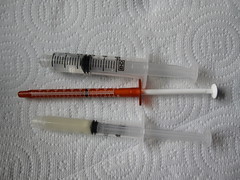
From the bottom to the top: a probiotic solution, erythromycin (an antibiotic with prokinetic properties) and sterile water to flush the drugs out of the feeding line and into his stomach. Max mainly gets drugs to help control his reflux, although he remains on a small dose of aldactazide (a brand-name combination of diuretics) left over from his lung problems in January. The idea is to let him "grow out" of the dose. The dosage of the other drugs will increase with his weight. Here's a picture of Carolyn delivering medicines (I love the expression on Max's face):
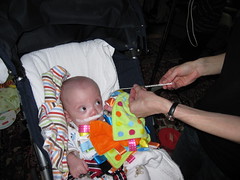
Over the course of the day, Max gets 19 separate doses of drugs, vitamins and so on. We find it easier to make a day's worth of medicines all at once and store them in baggies:

To keep all of this straight, Carolyn put together a daily schedule for Max with his feedings (attempts with the bottle, formula, breast milk etc) and drugs. In addition, we try to record notable events, although the definition of "notable" is becoming a little plastic. Here's a picture of a schedule, sitting next to a recipe for Max's formula:

(If you look closely you can see arithmetic in the margins--there's a great deal more long division than I would have thought.)
At night, we hook Max up to his monitor. Thankfully, he left his pulse-ox meter in the hospital, but we do still keep track of his breathing and heart rate. In my opinion, the monitor looks like a Soviet tape-deck, but we're told it's the latest thing in home health care:
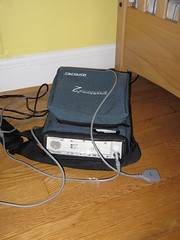
The monitor is connected to two leads taped to Max's chest: one measuring his heart rate, and the other measuring his respiration rate. Which is which? You don't want to get them backwards, or the monitor will think that he's taking 170 breaths per minute, but his heart is only 40 beats per minute. There's a handy mnemonic we use: "white on right". Ah-ha, but whose right? (Max's). And who can tell their right from their left in the night? Here is a picture of Max's chest, showing the leads. The leads are sticky, but can't stand up to baby sweat, spit up, etc, so we've added extra tape to hold them in place:
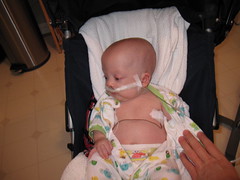
Finally, we keep tabs on Max using a video camera we placed in his room. We had a sound-only pickup in Felix's room that we dubbed "Radio Free Felix". We haven't decided which cable news network the video system best resembles yet.
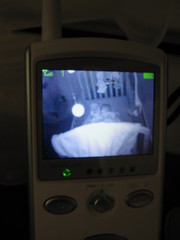
The monitor has a night-vision feature, showing a grainy black-and-white image in low light. Squinting at the tiny screen always reminds me footage of people watching the Apollo landings back in the 1970s.


